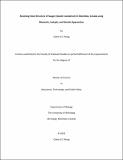| dc.contributor.author | Wong, Caleb H. S. | |
| dc.date.accessioned | 2023-12-21T21:47:20Z | |
| dc.date.available | 2023-12-21T21:47:20Z | |
| dc.date.issued | 2023-12-06 | |
| dc.identifier.citation | Wong, Caleb H. S. Resolving Stock Structure of Sauger (Sander canadensis) in Manitoba, Canada using Biometric, Isotopic, and Genetic Approaches; A thesis submitted to the Faculty of Graduate Studies in partial fulfillment of the requirements for the degree of Master of Science in Bioscience, Technology, and Public Policy. Winnipeg, Manitoba, Canada: The University of Winnipeg, 2023. DOI: 10.36939/ir.202312211545. | en_US |
| dc.identifier.uri | https://hdl.handle.net/10680/2129 | |
| dc.description.abstract | Many sauger (Sander canadensis) populations in Manitoba have declined in numbers and biomass. Fisheries managers have proposed a province-wide sauger management plan to protect and restore sauger populations, but they are uncertain how sauger populations should be defined and to what extent they may interact. In this thesis, I used a multifaceted approach to resolve population structure and identify migratory corridors of sauger in Manitoba. First, I mined biometric data from several long-term monitoring datasets to calculate life history indices for sauger stocks across 29 waterbodies. Sauger growth generally decreased and the age at 50% maturity increased among lakes of increasing latitude. This trend was also observed within Lake Winnipeg, yet the length at 50% maturity remained constant. Sauger grew exceptionally fast in Lake Manitoba and Lake Winnipegosis and matured at an early age. Next, I performed a stable isotope analysis (13C and 15N) of sauger tissue to investigate contemporary sauger migration throughout the Lake Winnipeg watershed. Sauger from Lake Winnipeg, Lake Manitoba, and Lac du Bonnet occupied distinct isotopic niches, and I identified several possible migrants from Lake Manitoba and the Winnipeg River in Lake Winnipeg. Finally, I used microsatellites to assess the genetic health and structure of sauger stocks across Manitoba. Genetic diversity within sample populations was moderate to high, and incidence of inbreeding and hybridization with walleye (Sander vitreus) was low. I identified four broad genetic sauger stocks: Lake Winnipeg; Lake Manitoba and Lake Winnipegosis; the Red and Assiniboine Rivers; and the Churchill and Saskatchewan Rivers. Gene flow between Lake Winnipeg and Lake Manitoba stocks is minimal. These findings will assist managers in defining stock management units and optimizing management efforts for sauger populations in Manitoba. | en_US |
| dc.description.sponsorship | Manitoba Fish and Wildlife Enhancement Fund (#FES19-010); Fish Futures (Dr. Ken Stewart Memorial Scholarship, 2021). | en_US |
| dc.language.iso | en | en_US |
| dc.publisher | University of Winnipeg | en_US |
| dc.rights | info:eu-repo/semantics/openAccess | en_US |
| dc.subject | Sauger (Sander canadensis) | en_US |
| dc.subject | Population structure | en_US |
| dc.subject | Stock structure | en_US |
| dc.subject | Migration | en_US |
| dc.subject | Life histories | en_US |
| dc.subject | Biometry | en_US |
| dc.subject | Stable isotope analysis | en_US |
| dc.subject | Population genetics | en_US |
| dc.subject | Conservation genetics | en_US |
| dc.subject | Microsatellites | en_US |
| dc.subject | Lake Winnipeg | en_US |
| dc.subject | Lake Manitoba | en_US |
| dc.subject | Lake Winnipegosis | en_US |
| dc.subject | Manitoba | en_US |
| dc.title | Resolving Stock Structure of Sauger (Sander canadensis) in Manitoba, Canada using Biometric, Isotopic, and Genetic Approaches | en_US |
| dc.type | Thesis | en_US |
| dc.description.degree | Master of Science in Bioscience, Technology, and Public Policy | en_US |
| dc.publisher.grantor | University of Winnipeg | en_US |
| dc.identifier.doi | 10.36939/ir.202312211545 | en_US |
| thesis.degree.discipline | Biology | |
| thesis.degree.level | masters | |
| thesis.degree.name | Master of Science in Bioscience, Technology, and Public Policy | |
| thesis.degree.grantor | University of Winnipeg | |

